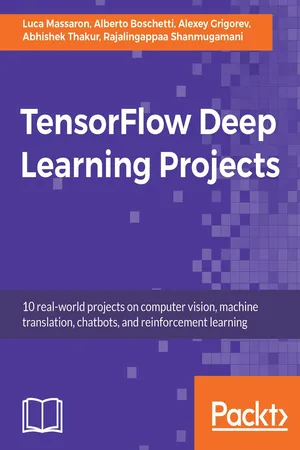
TensorFlow Deep Learning Projects
Alexey Grigorev, Rajalingappaa Shanmugamani, Alberto Boschetti, Luca Massaron, Abhishek Thakur
- 320 pagine
- English
- ePUB (disponibile sull'app)
- Disponibile su iOS e Android
TensorFlow Deep Learning Projects
Alexey Grigorev, Rajalingappaa Shanmugamani, Alberto Boschetti, Luca Massaron, Abhishek Thakur
Informazioni sul libro
Leverage the power of Tensorflow to design deep learning systems for a variety of real-world scenarios
Key Features
- Build efficient deep learning pipelines using the popular Tensorflow framework
- Train neural networks such as ConvNets, generative models, and LSTMs
- Includes projects related to Computer Vision, stock prediction, chatbots and more
Book Description
TensorFlow is one of the most popular frameworks used for machine learning and, more recently, deep learning. It provides a fast and efficient framework for training different kinds of deep learning models, with very high accuracy. This book is your guide to master deep learning with TensorFlow with the help of 10 real-world projects.
TensorFlow Deep Learning Projects starts with setting up the right TensorFlow environment for deep learning. Learn to train different types of deep learning models using TensorFlow, including Convolutional Neural Networks, Recurrent Neural Networks, LSTMs, and Generative Adversarial Networks. While doing so, you will build end-to-end deep learning solutions to tackle different real-world problems in image processing, recommendation systems, stock prediction, and building chatbots, to name a few. You will also develop systems that perform machine translation, and use reinforcement learning techniques to play games.
By the end of this book, you will have mastered all the concepts of deep learning and their implementation with TensorFlow, and will be able to build and train your own deep learning models with TensorFlow confidently.
What you will learn
- Set up the TensorFlow environment for deep learning
- Construct your own ConvNets for effective image processing
- Use LSTMs for image caption generation
- Forecast stock prediction accurately with an LSTM architecture
- Learn what semantic matching is by detecting duplicate Quora questions
- Set up an AWS instance with TensorFlow to train GANs
- Train and set up a chatbot to understand and interpret human input
- Build an AI capable of playing a video game by itself –and win it!
Who this book is for
This book is for data scientists, machine learning developers as well as deep learning practitioners, who want to build interesting deep learning projects that leverage the power of Tensorflow. Some understanding of machine learning and deep learning, and familiarity with the TensorFlow framework is all you need to get started with this book.
Domande frequenti
Informazioni
Detecting Duplicate Quora Questions
- Feature engineering on text data
- TF-IDF and SVD
- Word2vec and GloVe based features
- Traditional machine learning models such as logistic regression and gradient boosting using xgboost
- Deep learning models including LSTM, GRU, and 1D-CNN
Presenting the dataset

| How does Quora quickly mark questions as needing improvement? | Why does Quora mark my questions as needing improvement/clarification before I have time to give it details? Literally within seconds… |
| Why did Trump win the Presidency? | How did Donald Trump win the 2016 Presidential Election? |
| What practical applications might evolve from the discovery of the Higgs Boson? | What are some practical benefits of the discovery of the Higgs Boson? |